Latest news about Bitcoin and all cryptocurrencies. Your daily crypto news habit.
UniswapNFT — A New Generation of NFT Trading
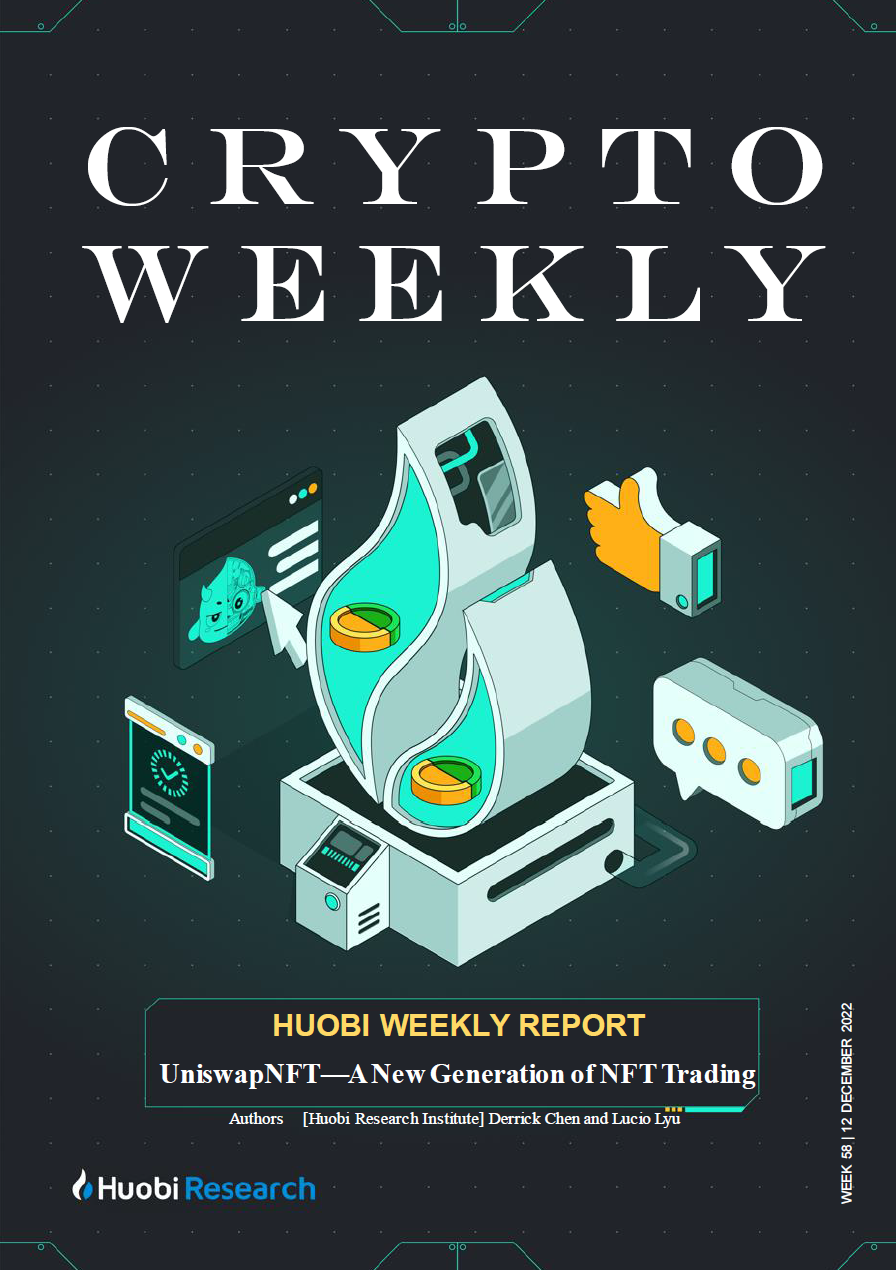
Abstract
This week, we focus on the following events: 1) Chainlink’s First Staking Pool Pulls in $170M of LINK Tokens, Hitting Community Limit After 2 Days; 2) Uniswap Foundation Proposes Changes to Crypto DEX’s Governance, Voting Processes; 3) India Looks to Coordinate Global Crypto Rulemaking as It Assumes G-20 Presidency.
Project Analysis: In December, Uniswap officially announced the launch of the NFT trading market, which is also a symbolic event of the gradual integration of the DeFi field and the NFT field. How will the market grow with huge number of users? In this report, we will introduce UniswapNFT and analyze it in different aspects.
1. Industry overview
I. Overall market trend
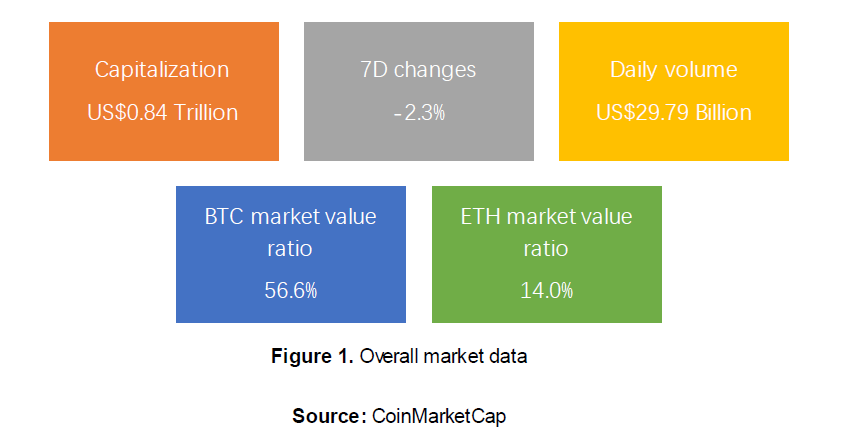
The global cryptocurrency market’s market cap this week changed a little, currently with a market cap of $840,065,880,728. Bitcoin is currently trading at US$16,935, continuing weeks below $20,000, showing no signs of going back to $20,000. Meanwhile, Ethereum, the second largest cryptocurrency, is currently trading at US$1,245, was slowing increasing. Among them, all tokens are increasing with TWT increasing the most at 9.39% in 7 days. Below is a graph for BTC and Inverted RRP, which RRP is an instrument used by the Fed to suck out liquidity from the markets by attracting investments from the markets themselves. The Inverted RRP may indicate sell-offs in equity markets (SPX/IXIC/Bitcoin) when it decreases, and vice versa.
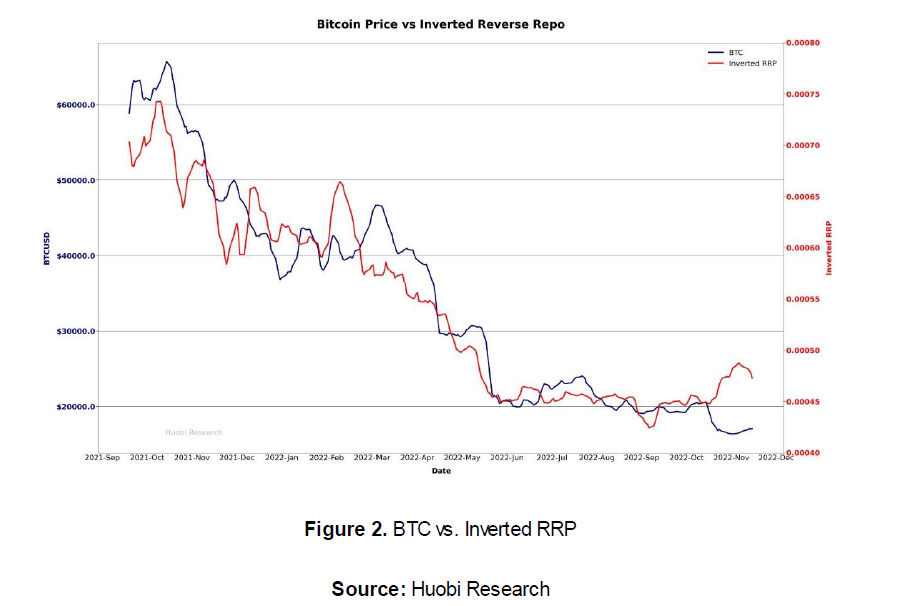
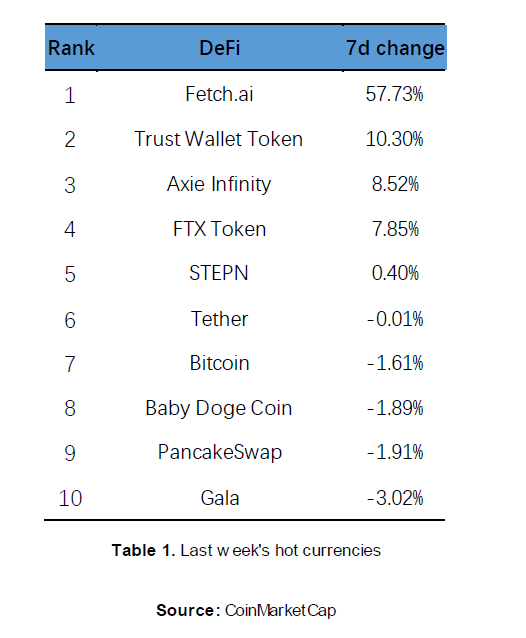
II.NFT
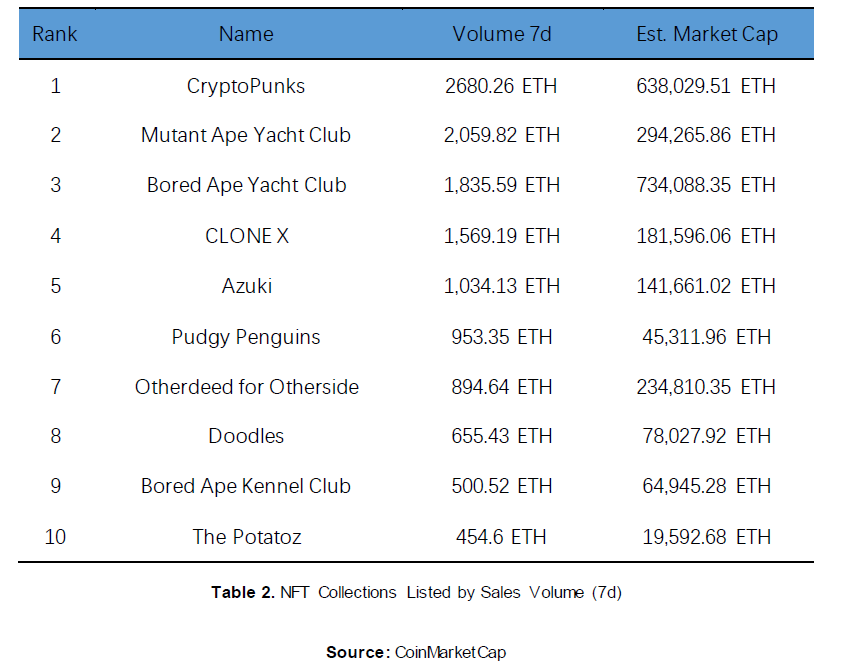
The NFT market last week saw an increase of 55.92%, with a market cap of US $2,396,084,123.64 this week. NFT market shows good in this week. The 7-day sales volume changed by 0.52% to $25,417,742.17 and total sales did not change very much at 0.78%, to 36.612. Overall, the sales declined a little bit. This week the top 10 NFT brands on Coinmarketcap are all familiar brands which has entered this list before, except the 6th, Pudgy Penguins with the biggest change of 0.17%.
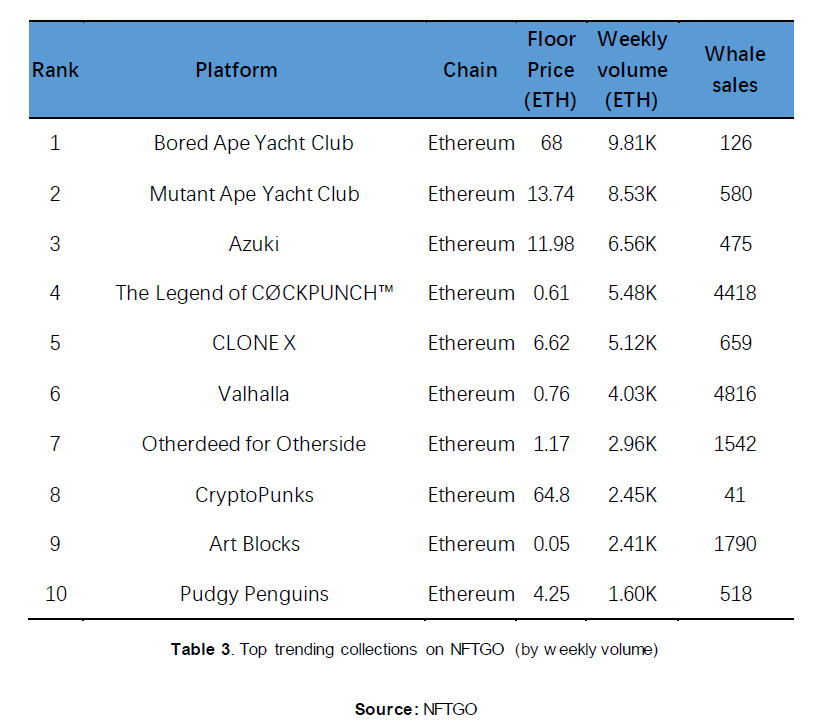
III.DeFi
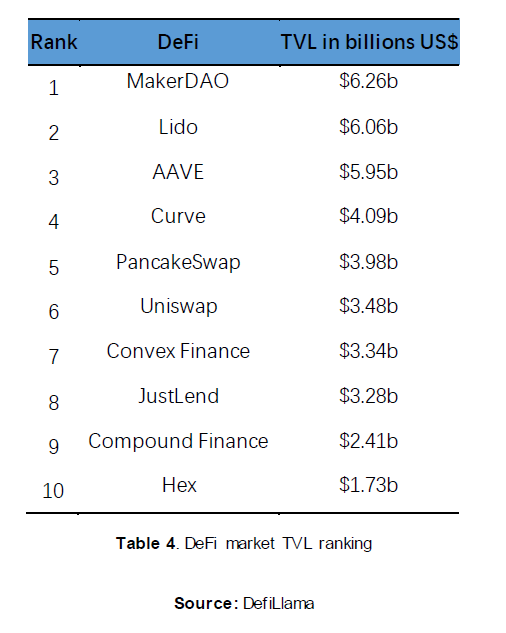
IV.Layer 2
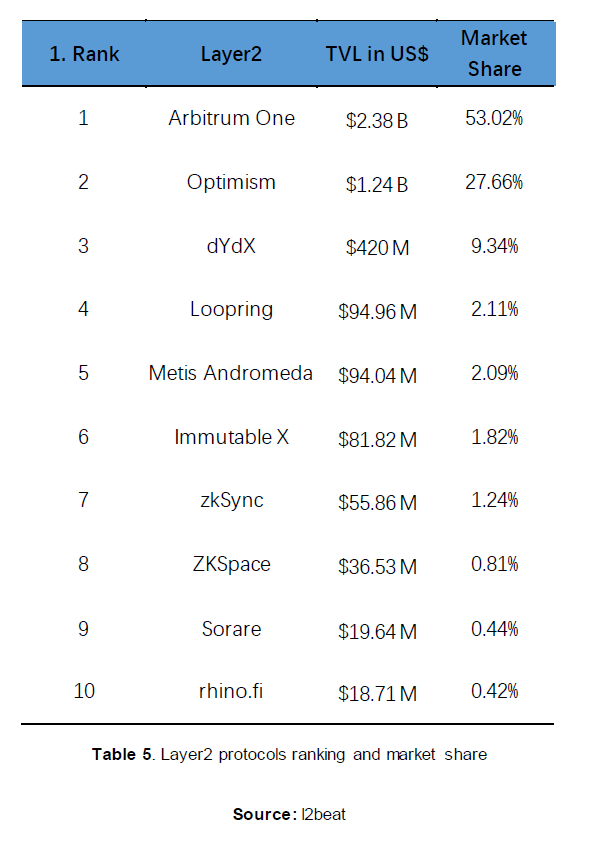
2. Market news (Source: Coindesk)
I. Industry news
Tokocrypto Token Holders Benefit from Reports of Binance Acquiring the Indonesian Exchange
Bitcoin ignored concerns about inflation, a cratering economy and the latest crypto woes, rising 2.3% over the previous 24 hours after a late Thursday surge.
The largest cryptocurrency by market capitalization was recently trading above $17,230, its highest point since early Monday.
BTC subsequently struggled to clear the $17,000 support it has held for much of the previous 10 days as fearful investors returned to risk averse crouches. Crypto markets have been fearful of events within the industry and beyond that might send prices tumbling levels to lower.
“It’s going to be a bit slower growth pattern,” JJ Kinahan, CEO of online trading firm IG North America, told CoinDesk TV’s “First Mover” program, although he added that he sensed “new money wanting to get into the market,” saying that investors were “over” a “crisis of confidence.”
Record Grayscale Bitcoin Trust Discount Widens Industry Woes
GBTC is a way for investors to gain exposure to bitcoin through a traditional investment vehicle. GBTC was trading at a discount rate of 47.3%, according to data from crypto index provider TradeBlock.
“The fact that Grayscale’s Bitcoin Trust is now trading at nearly 50% discount is just awful for holders of GBTC. It really highlights the vast differences in structure quality between different investment vehicles,” Bradley Duke, co-CEO at ETC Group, said in a note to CoinDesk.
Bearish sentiment surrounding the trust deepened over the last few weeks as fears surfaced that crypto trading firm Genesis Global Trading, which is owned by Grayscale’s parent company, Digital Currency Group (DCG), could file for bankruptcy.
Following the collapse of crypto exchange FTX, Genesis Global Trading announced on Nov. 16 that it would halt customer withdrawals from its lending unit, Genesis Global Capital. Amid speculation about a possible that filing, Genesis said in a note to clunesdayents on Wed of the lending unit’s withdrawal freeze is likely to be a matter of “weeks” rather than days.
GBTC shares haven’t traded at a premium to bitcoin since March 2021. Prior to that date, the trust benefited from strong institutional demand and traded at a double-digit premium to its net asset value.
Chainlink’s First Staking Pool Pulls in $170M of LINK Tokens, Hitting Community Limit After 2 Days
Chainlink, a provider of price feeds and other data for blockchains, had its first-ever staking pool draw in 24.27 million tokens worth some $170 million, with community allotment filling up in two days.
The new staking effort is designed to help secure the quality of the project’s price feed for the cryptocurrency ether (ETH). Under the system, participants and node operators commit their holdings of Chainlink’s LINK tokens as a form of guarantee, in exchange for 4.75% annualized rewards.
The Chainlink team tweeted at 1:51 p.m. ET on Thursday that the staking community pool’s limit of 22.5 million total LINK tokens was “100% filled.” While community allocation has been filled, node operators are still able to stake their LINK tokens because the overall staking pool is capped at 25 million LINK. This leaves node operators with roughly 730,000 remaining LINK tokens to stake.
II. Investment and Financing
Uniswap Foundation Proposes Changes to Crypto DEX’s Governance, Voting Processes
The Uniswap Foundation is putting to vote a series of governance changes that it said would streamline voting in the decentralized autonomous organization that manages Uniswap, one of the most popular venues for decentralized crypto trading.
Uniswap community members will get to vote on Dec. 14 on a restructuring package that will “improve efficiency and efficacy” for the DAO, according to a forum post by Devin Walsh, the foundation’s executive director.
The biggest changes would see Uniswap governance reduce its requirement for off-chain “snapshot votes” that precede on-chain votes. It would drastically raise the barrier for clearing preliminary votes, a move that will “prevent lower quality proposals” from breaking through, according to Walsh’s blog.
Final governance votes (the on-chain votes that approve or deny proposals) will remain the same.
“One of the Uniswap Foundation’s mandates is to enable better decision-making by the DAO, and a pain point has been the community governance process,” Walsh told CoinDesk. “We are pleased that this proposal has received so much feedback from delegates, and are excited for these changes to both increase the process’s effectiveness as well as reduce its operational overhead.”
Uniswap community members have been active in their efforts to streamline governance and limit friction within the protocol. In August, they voted to create the Uniswap Foundation, in an effort to bolster the community around its treasury management.
FalconX Discloses Assets Locked on FTX
Crypto trading firm FalconX said Thursday it has a portion of its assets locked on failed crypto exchange FTX.
“FalconX balances locked on FTX represented 18% of our unencumbered cash equivalents. This ratio was within our counterparty exposure limits,” FalconX said in a blog post.
It said it will remain well-capitalized even if it has to write those assets off as a total loss. FalconX said it does not have exposure to Genesis, Alameda or BlockFi.
“Recent events have validated our approach to risk management. We are market risk neutral and extend credit overcollateralized on our platform. We utilize real-time risk monitoring, and we operate within the confines of our counterparty exposure limits,” the blog post said.
Bitcoin’s Lightning Network Could Be Getting a Privacy Upgrade
The Lightning Network, Bitcoin’s layer 2 scaling platform, has a privacy problem. Receiving payments, requesting refunds, and opening and closing payment channels (connections between Lightning nodes) — all raise privacy concerns for users of the payment network.
Those concerns have inspired protocol-based solutions like “Basis of Lightning Technology 12” (BOLT 12), a proposed system that not only enhances privacy but also introduces many other useful features.)
Independent systems have also sprung up — notably, lnproxy, an invoice privacy tool (invoices are simply payment requests), and LNURL, a suite of tools for enabling communication between various Lightning applications and services over the web.
III. Supervision
India Looks to Coordinate Global Crypto Rulemaking as It Assumes G-20 Presidency
India, a country that has at times sought to ban and severely limit crypto usage within its borders, has as of Dec. 1st assumed the presidency of the Group of 20 — the intergovernmental forum of some of the world’s largest economies — just as much of the world is pondering whether stricter regulation of the industry is needed.
As India takes over the group, which includes 19 nations and the European Union as a bloc, for the next year, the country will bear the responsibility of shaping the group’s agenda.
Prime Minister Narendra Modi is no stranger to crypto. He has previously called for global cooperation to tackle challenges posed by cryptocurrencies as the technology “makes decisions taken by one country inadequate to meet the challenges.” India and its prime minister will host the 18th G-20 summit in New Delhi next year, Sept. 9–10.
The prioritizing of framing globally coordinated crypto rules reflects a renewed urgency for tighter regulations amid another chapter of crypto contagions triggered by the collapse of FTX.
EU’s McGuinness Urges Speedier Vote on Long-Delayed Crypto Laws
European Union Commissioner Mairead McGuinness wants to speed up a vote on landmark crypto laws that has been repeatedly pushed back for procedural reasons, according to a Nov. 29 letter seen by CoinDesk.
The letter, which was given to CoinDesk in response to a freedom-of-information request, is the latest indication that the European Commission is getting antsy about delays to its landmark crypto-regulation bill, called markets in crypto assets, or MiCA, which it sees as more urgent now in the wake of the collapse of crypto exchange FTX.
“Recent events have highlighted once again the importance of having adequate regulation of crypto markets” to protect clients’ assets and the wider economy, McGuinness, who is the EU’s commissioner for financial services, said in the letter to Irene Tinagli, the chairwoman of the European Parliament’s Economic and Monetary Affairs Committee, and Czech Finance Minister Zbyněk Stanjura, who is also the chairman of the EU’s Council of Economy and Finance Ministers.
“I would ask you to do your utmost to ensure a rapid vote and subsequent publication of the MiCA and TFR (transfer of funds) regulations,” McGuinness wrote. McGuinness she wants the rules to come into force at the latest in spring of next year. The TFR is a parallel law intended to counter money laundering and requires crypto companies to verify the identity of those making transfers.
Japanese Regulator Extends FTX Japan’s Suspension as Users Wait for Their Funds
Japan’s Financial Services Agency (FSA) has extended FTX Japan’s suspension to March 9. An earlier suspension order, issued on Nov. 10 after FTX Japan halted user withdrawals, was set to expire on Friday.
The FSA reiterated its earlier position, saying that it is necessary to take all possible measures to ensure that FTX Japan’s assets do not flow out to overseas affiliates and that the interests of users are not harmed.
Japan may be one of very few jurisdictions where FTX customers might be able to receive their funds back, following the collapse of Sam Bankman-Fried’s crypto exchange in early November.
3. Project Analysis — UniswapNFT
I. Background of UniswapNFT
Uniswap announced its acquisition of NFT marketplace aggregator Genie on June 21. After that, the Uniswap NFT platform was actually transformed from Genie. UniswapNFT is an NFT market aggregator. Users can trade on this platform from many different markets. Now enter the official website of Genie, it will automatically jump to the UniswapNFT website. The main interface of Uniswap NFT is very concise, except for the slogan “Better Prices. More Listings.” There are only two sections. The first is the Trending NFT Collections ranking, which defaults to the trading volume ranking. The second is the floor price comparison of some NFT Collections on different platforms in the upper right corner. (The floor price of sudoswap is included in the quotation of Uniswap NFT by default)
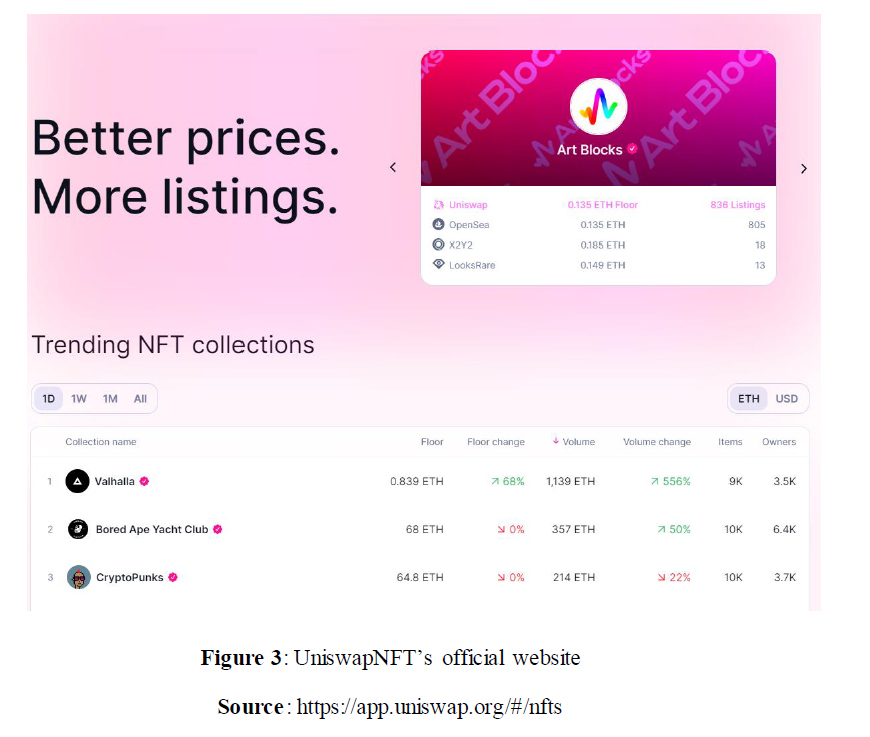
II. Functions of UniswapNFT
In the independent interface of each NFT Collection, the functions and user experience are almost consistent with those of the Genie platform. On the right bottom of the picture of each NFT, it shows where the NFT from. However, it is still missing the most important function of the NFT aggregator: the transaction-related data panel function. We also believe that this piece of content will be completed in a later update.
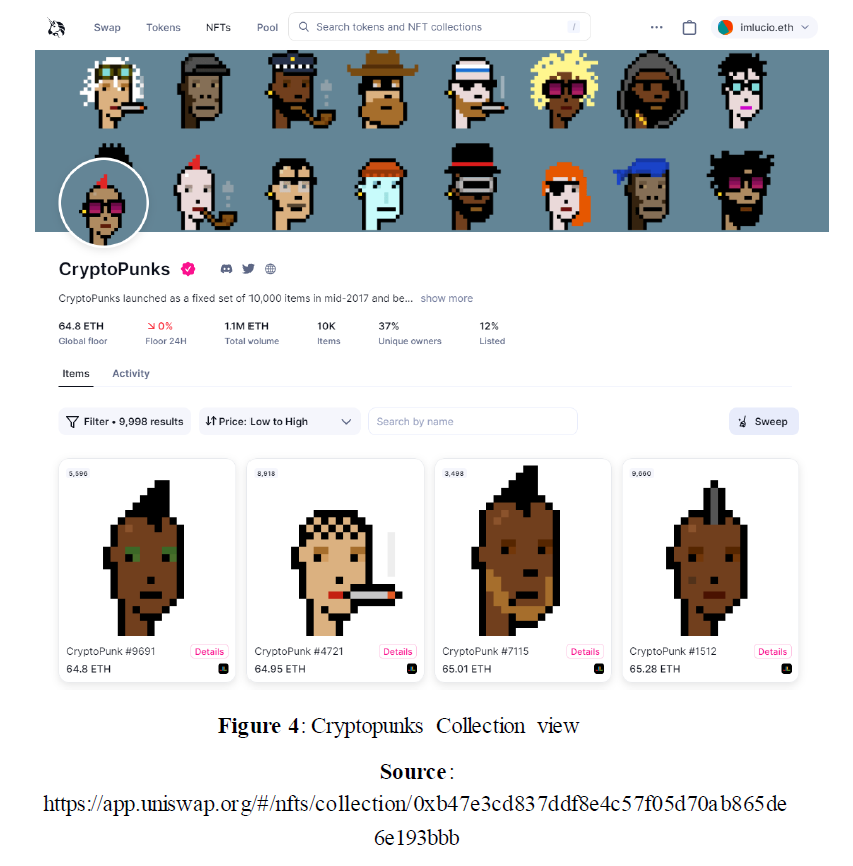
III. Where is the value of this aggregator?
For a period of time, the function of “Sweep floor” has catered to the hype of the project side, the rush of investors to buy, and the selection of easy-to-use tools for retail investors. Therefore, it has good traffic and brings order transactions. In fact, half of the orders of x2y2 come from aggregators. Compared with traditional trading markets, NFT aggregators have some obvious advantages, including:
- Highly aggregated information: such as transaction volume, floor price, transaction price, quantity, top holders, top buyers, etc.
- Highly aggregated operations: Users can view, trade and purchase NFTs on all markets through one platform.
- Improve transaction efficiency: information and operation aggregation, easy price comparison decision.
- Diversified payment methods: Ideally (supported by the third-party market protocol itself), any token can be used for payment on the NFT aggregation platform.
On the whole, it is for the project party itself to do the market liquidity, to buy and sell in batches for large investors, and to obtain benefits and access to various users of retail observation data information. Therefore, the aggregator is going further and further on the road of tool attributes. The competition is also becoming more and more intense, that is, to test how to reduce the loss of 6W in the implementation of the contract and how the instrumental platform can better present the data, but the author believes that the main value and goal of Uniswap’s NFT market is not to be an easy-to-use. It is a good tool, but expects to realize a unified on-chain interaction protocol, aiming at how to achieve a smoother transaction process when the payment method is not ideal.
IV. Permit2 — Efficient, consistent, and secure approvals
Permit2 is a token approval contract that can safely share and manage token approvals across different smart contracts. As more projects integrate with Permit2, we can standardize token approvals across all applications. smart contract security.
Originally defined in EIP-20, the canonical token approve method suffered from a couple of weaknesses:
Users had to send an approval transaction for each new application they wanted to use. This led to a confusing UX where users might be asked to send multiple transactions before using an application, wasting gas and time.
For convenience’s sake, applications asked users to approve the maximum allowance, giving applications access to a wallet’s entire token balance for an infinite amount of time. Though Uniswap has never suffered from an exploit, infinite approvals can be hacked to steal user’s tokens, to revoke active allowances.
EIP-2612 iterated on token approvals. Users could interact with application contracts without requiring prior approval by appending a signed permit message to their transaction. While EIP-2612 made token approvals safer with granular allowance approvals, tokens Eupid2not launched before IP-26 the permit function and not all newer tokens have adopted it.
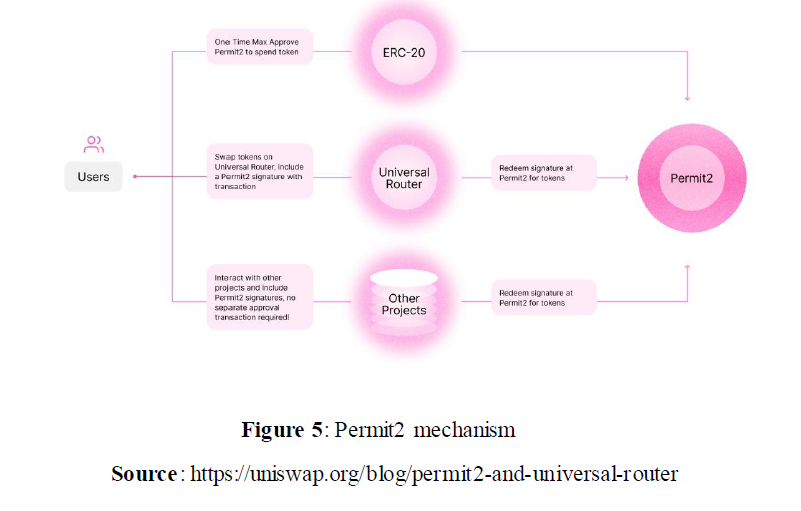
How Permit2 improves UX
Permit2 further iterates on the token approval mechanism by introducing signature-based approvals and transfers for any ERC20 token, regardless of EIP-2612 support. Permit2 also comes with a host of exciting features that unlock more secure token approval user options and enable a more experience across any integrating application. The full list of features can be found in our docs, but notably:
Permits for any token. Applications can have a single transaction flow by sending a signature along with the transaction data for any token, including those not supporting a native permit method.
Expiring approvals. Approvals can be time-bound, removing security concerns around hanging approvals on a wallet’s entire token balance. Revoking approvals do not necessarily have to be a new transaction.
Signature-based transfers. Users can bypass setting allowances entirely by releasing tokens to a permissioned spender through a one-time signature.
Batch approvals and transfers. Users can set approvals on multiple tokens or execute multiple transfers with one transaction.
Batch revoking allowances. Remove allowances on any number of tokens and spenders in one transaction.
V. Universal Router — Unified token and NFT swaps
We’ve integrated Permit2 into another exciting contract we’re releasing. The Universal Router is Uniswap’s next-generation router that unifies token and NFT trades into a highly flexible, gas-optimized, secure, and extensible swap router. The Universal Router pro sign product and user experience, which is why it will become the default swap router for all Uniswap swaps in the near future.
Swap routers take in defined parameters (e.g. swap route, maximum slippage, and swap recipient) and execute swaps against your desired venues (e.g. Uniswap pools, NFT marketplaces). Swap routers are optimized to find the lowest prices and at execute them cost.
However, current swap routers suffer from two inefficiencies:
- Existing swap routers typically only support either NFTs or ERC20 tokens. Trades that involve both currently require multiple transactions. For example, buying an NFT with an ERC20 token would require two separate transactions. First, a swfinal from DAI to ETH, and then swap from ETH to NFT.
- Because swap routers are responsible for transferring user tokens, users must approve every token on first use, making them costly to upgrade. This is especially problematic for aggregator swap routers as contracts must be redeployed each time a new protocol is supported.
How Universal Router unifies swaps
With the Universal Router, users can execute multiple token swaps on Uniswap V2 & V3, and buy NFTs from multiple marketplaces all in one transaction. For example, envision a swap that
- Uses three different input tokens
- Swaps on Uniswap V2 and V3 using a split route
- Performs an ETH to WETH wrap
- Buys an NFT on OpenSea
This entire flow can be executed as a single transaction.
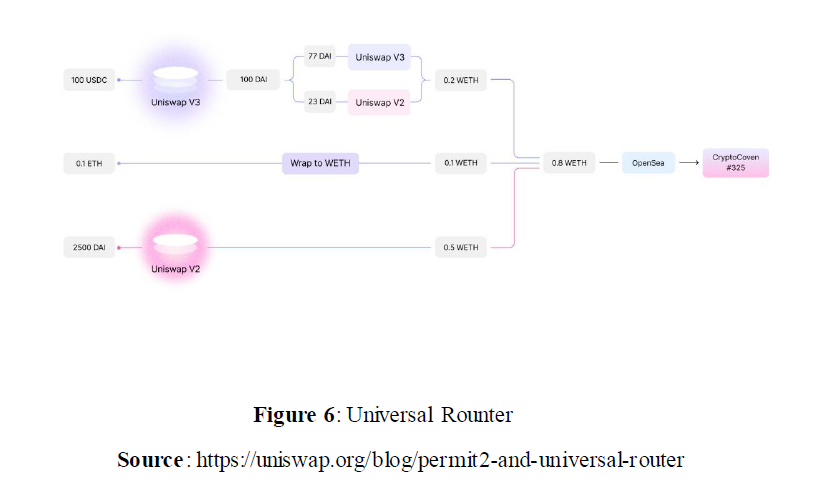
The Universal Router is integrated with Permit2, meaning that users approve with Permit2 and pass their signature through to the Universal Router, abstracting the token approval flow from the router contracts. Developers can deploy new versions of the Universal Router without requiring users to send a separate approval transaction each time. This allows the Universal Router — or any integrated contract — to remain immutable, while also allowing new features to be added in the future.
VI. Conclusion
In my opinion, the goal of UniswapNFT is very ambitious, to become a habit for users to trade NFT. As an aggregator, it includes many mainstream trading platforms, and users only need to trade NFTs of different platforms on a single platform. The interface of the trading platform is simple, the operation is simple, and the user experience is very smooth. As a successful team, there is no doubt about its development ability. As the largest traffic portal in the DeFi field, Uniswap will perform very well while developing NFT market business.
At the same time, as an NFT aggregator, UniswapNFT still needs to update and optimize many things, such as market analysis. As an aggregator, huge data sources and more comprehensive analysis functions will also retain more customers.
About Huobi Research Institute
Huobi Blockchain Application Research Institute (referred to as “Huobi Research Institute”) was established in April 2016. Since March 2018, it has been committed to comprehensively expanding the research and exploration of various fields of blockchain. As the research object, the research goal is to accelerate the research and development of blockchain technology, promote the application of the blockchain industry, and promote the ecological optimization of the blockchain industry. The main research content includes industry trends, technology paths, application innovations in the blockchain field, Model exploration, etc. Based on the principles of public welfare, rigor and innovation, Huobi Research Institute will carry out extensive and in-depth cooperation with governments, enterprises, universities and other institutions through various forms to build a research platform covering the complete industrial chain of the blockchain. Industry professionals provide a solid theoretical basis and trend judgments to promote the healthy and sustainable development of the entire blockchain industry.
Contact us:
Website:http://research.huobi.com
Email:research@huobi.com
Twitter:https://twitter.com/Huobi_Research
Telegram:https://t.me/HuobiResearchOfficial
Medium:https://medium.com/huobi-research
Disclaimer
1. The author of this report and his organization do not have any relationship that affects the objectivity, independence, and fairness of the report with other third parties involved in this report.
2. The information and data cited in this report are from compliance channels. The sources of the information and data are considered reliable by the author, and necessary verifications have been made for their authenticity, accuracy and completeness, but the author makes no guarantee for their authenticity, accuracy or completeness.
3. The content of the report is for reference only, and the facts and opinions in the report do not constitute business, investment and other related recommendations. The author does not assume any responsibility for the losses caused by the use of the contents of this report, unless clearly stipulated by laws and regulations. Readers should not only make business and investment decisions based on this report, nor should they lose their ability to make independent judgments based on this report.
4. The information, opinions and inferences contained in this report only reflect the judgments of the researchers on the date of finalizing this report. In the future, based on industry changes and data and information updates, there is the possibility of updates of opinions and judgments.
5. The copyright of this report is only owned by Huobi Blockchain Research Institute. If you need to quote the content of this report, please indicate the source. If you need a large amount of references, please inform in advance (see “About Huobi Blockchain Research Institute” for contact information) and use it within the allowed scope. Under no circumstances shall this report be quoted, deleted or modified contrary to the original intent.
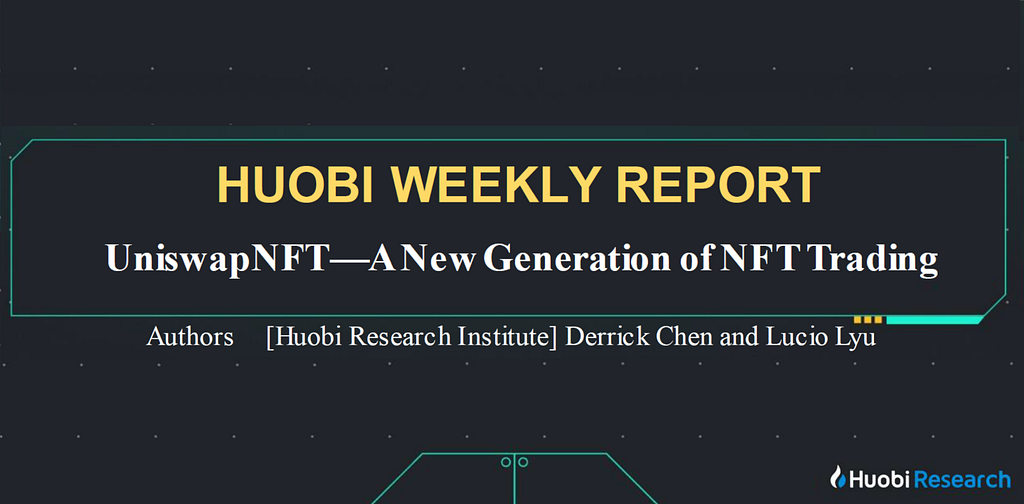
UniswapNFT — A New Generation of NFT Trading was originally published in Huobi Research on Medium, where people are continuing the conversation by highlighting and responding to this story.
Disclaimer
The views and opinions expressed in this article are solely those of the authors and do not reflect the views of Bitcoin Insider. Every investment and trading move involves risk - this is especially true for cryptocurrencies given their volatility. We strongly advise our readers to conduct their own research when making a decision.